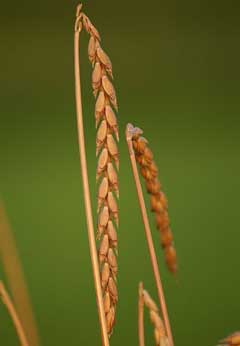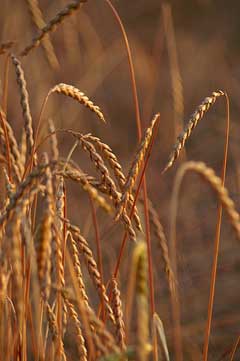 |
|
commons.wikimedia.org/wiki/User:Böhringer |
 |
| commons.wikimedia.org/wiki/User:Böhringer |
Translate this page:
Summary
Physical Characteristics

 Triticum aestivum spelta is a ANNUAL growing to 1 m (3ft 3in).
Triticum aestivum spelta is a ANNUAL growing to 1 m (3ft 3in).
It is not frost tender. It is in flower from June to July, and the seeds ripen from August to September. The species is hermaphrodite (has both male and female organs) and is pollinated by Wind.
Suitable for: light (sandy), medium (loamy) and heavy (clay) soils, prefers well-drained soil and can grow in nutritionally poor soil. Suitable pH: mildly acid, neutral and basic (mildly alkaline) soils. It cannot grow in the shade. It prefers moist soil.
UK Hardiness Map
US Hardiness Map
Synonyms
Plant Habitats
Cultivated Beds;
Edible Uses
Edible Parts: Seed
Edible Uses:
Seed - cooked[57, 61, 105]. It is usually ground into a flour and used as a cereal for making bread, biscuits etc. Pasta made from this grain has a delicious nutty flavour[183]. The seed retains its glumes when threshed[46].
References More on Edible Uses
Medicinal Uses
Plants For A Future can not take any responsibility for any adverse effects from the use of plants. Always seek advice from a professional before using a plant medicinally.
None known
References More on Medicinal Uses
The Bookshop: Edible Plant Books
Our Latest books on Perennial Plants For Food Forests and Permaculture Gardens in paperback or digital formats.

Edible Tropical Plants
Food Forest Plants for Hotter Conditions: 250+ Plants For Tropical Food Forests & Permaculture Gardens.
More

Edible Temperate Plants
Plants for Your Food Forest: 500 Plants for Temperate Food Forests & Permaculture Gardens.
More

More Books
PFAF have eight books available in paperback and digital formats. Browse the shop for more information.
Shop Now
Other Uses
Biomass Mulch Paper Starch Thatching
The straw has many uses, as a biomass for fuel etc, for thatching, as a mulch in the garden etc[141]. A fibre obtained from the stems is used for making paper[189]. The stems are harvested in late summer after the seed has been harvested, they are cut into usable pieces and soaked in clear water for 24 hours. They are then cooked for 2 hours in lye or soda ash and then beaten in a ball mill for 1½ hours in a ball mill. The fibres make a green-tan paper[189]. The starch from the seed is used for laundering, sizing textiles etc[46, 61]. It can also be converted to alcohol for use as a fuel.
Special Uses
References More on Other Uses
Cultivation details
An easily grown plant, it succeeds in most well-drained soils in a sunny position. Succeeds in poor soils[171]. Spelt probably arose through cultivation around 8,000 years ago following a cross between T. dicoccum and Aegilops squarrosa. This cross contributed an extra protein gene to the seed, making a stronger flour that is more suitable for making bread. It is sometimes cultivated for its edible seed, especially in the hilly country of C. and N.W. Europe[50, 57, 183]. There are some named varieties[183]. It is becoming increasingly popular as a health-food crop, although it contains gluten it is said to be more nutritious than bread wheat and suitable for many people who are intolerant of the gluten in bread wheat A hexaploid species[142].
References Carbon Farming Information and Carbon Sequestration Information
Temperature Converter
Type a value in the Celsius field to convert the value to Fahrenheit:
Fahrenheit:
The PFAF Bookshop
Plants For A Future have a number of books available in paperback and digital form. Book titles include Edible Plants, Edible Perennials, Edible Trees,Edible Shrubs, Woodland Gardening, and Temperate Food Forest Plants. Our new book is Food Forest Plants For Hotter Conditions (Tropical and Sub-Tropical).
Shop Now
Plant Propagation
Seed - sow early spring or autumn in situ and only just cover the seed. Germination should take place within a few days[K].
Other Names
If available other names are mentioned here
Native Range
Coming Soon
Weed Potential
Right plant wrong place. We are currently updating this section.
Please note that a plant may be invasive in one area but may not in your area so it's worth checking.
Conservation Status
IUCN Red List of Threatened Plants Status :

Growth: S = slow M = medium F = fast. Soil: L = light (sandy) M = medium H = heavy (clay). pH: A = acid N = neutral B = basic (alkaline). Shade: F = full shade S = semi-shade N = no shade. Moisture: D = dry M = Moist We = wet Wa = water.
Now available:
Food Forest Plants for Mediterranean Conditions
350+ Perennial Plants For Mediterranean and Drier Food Forests and Permaculture Gardens.
[Paperback and eBook]
This is the third in Plants For A Future's series of plant guides for food forests tailored to
specific climate zones. Following volumes on temperate and tropical ecosystems, this book focuses
on species suited to Mediterranean conditions—regions with hot, dry summers and cool, wet winters,
often facing the added challenge of climate change.
Read More
Expert comment
Author
(L.)Thell.
Botanical References
50
Links / References
For a list of references used on this page please go here
Readers comment
© 2010, Plants For A Future. Plants For A Future is a charitable company limited by guarantee, registered in England and Wales. Charity No. 1057719, Company No. 3204567.